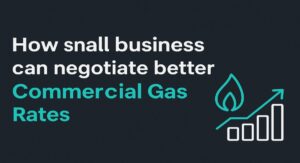Managing growing energy costs is one of the most urgent problems facing small business owners in the UK. Whether you run an office, retail store, or café, electricity is a necessary expense. Comprehending Average Electricity Bills facilitates efficient budgeting, tariff comparison, and cost-cutting opportunities for business owners.
We’ll explain how charges are determined, provide actual examples for various business types, break down the average electricity bill, and provide doable cost-cutting strategies in this comprehensive guide. Small business owners can take charge of their energy costs in 2025 and beyond with the right information, case studies, and resources.
Our area of expertise at Price Buddy is assisting UK companies in comprehending and maximising their energy expenses. This post is meant to give you clarity and doable actions so that your small business’s electricity bill is never a mystery again.
What Are Average Electricity Bills for UK Businesses?

Electricity consumption varies with the size of the business. Usually, suppliers and the government categorise companies based on how many kilowatt-hours (kWh) they consume annually:
- Micro business: Uses less than 15,000 kWh annually (e.g., a small kiosk or barber shop).
- Small business: Uses between 15,000–50,000 kWh annually (e.g., a small café or local office).
- Medium business: Consumes 50,000–100,000 kWh annually (e.g., a larger retail store or manufacturing unit).
When calculating your average small business electricity bill, it’s important to know where your company stands on this scale.
Why does the average electricity bill vary
There is no “one-size-fits-all” cost. Factors influencing the electricity bill average include:
- Business type (e.g., cafes use more energy than offices).
- Equipment and appliances (ovens, refrigerators, computers).
- Opening hours (longer trading = higher bills).
- Tariff type and contract length.
- Location (network charges differ across UK regions).
Because of this, comparing your electricity bill to the market average only provides a baseline; your actual expenses will vary based on your particular usage habits.
Current Electricity Bill Average in the UK (2025 Update)
Since business energy costs in the UK have changed significantly in recent years, it is crucial for owners to keep abreast of the most recent data. Both current unit rates and standing charges, which make up the majority of total expenses, are represented in the average electricity bill for small businesses in 2025.
Typical unit rates (p/kWh) and standing charges
Businesses in the UK are paying between 20p and 28p per kWh for electricity as of mid-2025, with a daily standing charge ranging from 45p to 80p, depending on the supplier and tariff. The wholesale market prices, which have been erratic in recent years, affect these rates.
As a result, averages are still helpful for planning, even though a typical business electricity bill can vary greatly.
How an Electricity Bill for Business Is Calculated
A business electricity bill is made up of several elements:
- Unit rate: The cost per kWh of energy consumed.
- Standing charge: A fixed daily fee for maintaining the supply.
- VAT: Most businesses pay 20% VAT on energy.
- Levies: Environmental and policy costs (e.g., Renewables Obligation).
- Network charges: Cover distribution and transmission infrastructure.
Understanding these components helps you see why bills add up beyond just usage.
How to read your electricity bill
A typical electricity bill includes:
- Supply number and meter reference.
- Breakdown of kWh consumed.
- Cost before VAT.
- VAT and levies.
- Final amount due.
At Price Buddy, we often help clients audit their electricity bill for business to ensure they are billed correctly and not paying hidden charges.
Average Electricity Bills for a Small Business by Size
Depending on the size of the company and its energy usage, electricity prices can vary significantly. Small business owners can compare their usage to industry standards by looking at averages.
Annual costs for micro, small, and medium businesses
- Micro businesses: £1,000–£2,000/year.
- Small businesses: £2,500–£5,000/year.
- Medium businesses: £5,000–£12,000/year.
These ranges reflect typical average electricity bills in 2025.
Seasonal usage and high-consumption industries
- Hospitality & catering: High energy demand year-round.
- Retail: Peaks during festive seasons (extra lighting/heating).
- Offices: Usage varies by working hours and staff levels.
How to Estimate Your Small Business Electricity Bill

It doesn’t have to be difficult to estimate your electricity expenses. You can quickly determine a realistic estimate of your monthly or annual bills by combining your usage data with the current unit rates.
Step-by-step calculation example
- Find your annual kWh usage (from meter or past bills).
- Multiply by your unit rate (e.g., 18,000 × 24p = £4,320).
- Add standing charges (e.g., £300/year).
- Add VAT (20%).
Result = Your estimated annual small business electricity bill.
Electricity bill calculator tool
To quickly determine the average of your electricity bills, use our free online calculator at Price Buddy. To obtain an accurate estimate, just enter your tariff information and kWh usage.
How to Reduce Your Average Electricity Bills
One of the simplest ways for small businesses to increase their profitability is to lower their energy expenses. Over the course of the year, even small adjustments to your electricity usage can result in significant savings.
Quick savings tips for small business electricity bills
Without making significant investments, you can quickly reduce your bills by making small adjustments to your daily operations. For instance, you can avoid wasting electricity by shutting off devices that aren’t in use, like printers, coffee makers, and display screens. Another easy win is switching to LED lighting from old bulbs because they last longer and use up to 80% less energy. To make sure lights and gadgets aren’t left on all night, smart plugs and timers can also help automate shut-offs. When combined, these easy solutions can reduce a small business’s electricity costs by 10–15% with little work.
Investments and upgrades to lower electricity costs
Investing in energy efficiency pays off in the long run. Although upgrading to A-rated or energy-efficient appliances may cost more up front, monthly bills will go down because they use a lot less electricity. Businesses with larger spaces can reduce energy waste by upgrading heating or cooling systems and improving insulation. Some companies are also opting for solar panels; although they are more expensive initially, self-generation can lock in predictable costs and lessen dependency on the grid, which will eventually result in lower average electricity bills.
Smart meters, tariffs, and renewable options
Businesses can identify waste and control peak usage with the help of smart meters, which provide real-time consumption insights. Because electricity costs less during off-peak hours, combining a smart meter with a time-of-use tariff can further lower bills. Last but not least, a lot of suppliers now provide renewable energy contracts, which can boost your sustainability credentials and offer stable pricing. Some of the best strategies to reduce your average electricity costs without sacrificing business operations are these combined actions.
Comparing Electricity Bills for Business Tariffs

Selecting the appropriate tariff is equally as crucial as managing your usage. The cost per unit of energy is directly influenced by the contract you are under.
Fixed vs variable vs flexible tariffs
A fixed tariff gives businesses stability and aids in more precise budgeting by locking in your price for the term of your contract. Variable tariffs fluctuate in tandem with wholesale energy prices; they are advantageous in declining markets but dangerous in rising ones. Larger companies can buy energy blocks at different times with flexible tariffs, which are a hybrid. Fixed tariffs offer the greatest peace of mind for a large number of smaller businesses.
Switching suppliers for better rates
Energy markets are competitive, and new customers are frequently offered attractive rates by suppliers. You can control your small business electricity bill by routinely comparing and switching. In order to save you the trouble of shopping around, Price Buddy offers free supplier comparisons. Annual contract reviews help businesses save hundreds of pounds annually.
Electricity Meters and Their Impact on Bills
The type of meter that is installed at your location may have an impact on the available tariffs as well as how you are billed. You can make sure you’re on the best contract by being aware of your meter type.
Half-hourly vs standard meters
Every 30 minutes, half-hourly meters automatically transmit readings to your supplier. They assist larger companies in obtaining more specialized tariffs and are required for companies using more than 100,000 kWh annually. Standard meters, typically read monthly or quarterly, are found in smaller businesses. Even though they are less accurate, they are simpler to handle and still offer sufficient information for the majority of small businesses to keep costs under control.
Single-rate vs time-of-use tariffs
No matter when you use electricity, you pay the same amount per kWh when you have a single-rate tariff. Time-of-use tariffs, on the other hand, impose varying rates based on demand; they are lower on weekends or at night and higher during peak hours. These tariffs can significantly lower business electricity bills for companies that can move operations, such as charging equipment or running dishwashers, off-peak.
Government Support for Small Business Electricity Bills
Government programs are in place to promote energy efficiency and lessen the impact of growing expenses. You can avoid losing out on possible savings by keeping up with these options.
Grants, schemes, and energy efficiency support
Local councils and the UK government provide a range of support. This includes tax breaks for companies that invest in green technology, grants for energy-efficient improvements, and sporadic exemptions from levies for industries that meet certain requirements. By reducing ongoing consumption and expenses, these supports can significantly impact a small business’s average electricity bill.
Tenant vs landlord electricity bill responsibilities
It’s critical for companies using rented space to know who is responsible for paying the energy bills. In certain situations, the landlord will pay the business’s electricity bill and include it in the rent. In others, tenants are directly in charge of overseeing their own contracts and supply. Always carefully review lease agreements to prevent misunderstandings and unanticipated fees.
Frequently Asked Questions
What is the average electricity bill for a small business?
Small businesses usually pay between £2,500 and £5,000 a year for electricity. The size, type, and hours of operation of the business all affect costs. For instance, compared to cafés or stores that run lights and equipment all day, offices typically use less electricity.
How much does a cafe or shop pay monthly?
Retail stores typically spend between £250 and £300 a month, while cafes typically spend between £350 and £450. These numbers vary depending on the tariff selected, opening hours, and energy efficiency. Over time, keeping an eye on usage can help small businesses lower their electricity costs.
Does the price cap affect business electricity bills?
No, businesses are not subject to the UK’s energy price cap, only households. This implies that suppliers and the wholesale market determine the electricity costs for business contracts. To get the best prices, businesses must frequently switch suppliers or shop around.
How can I lower my electricity bill quickly?
Installing smart plugs or timers, switching to LED lighting, and shutting off unused equipment are all examples of quick wins. Without making significant financial investments, these minor changes can lower the average electricity bill by up to 15%.
Which UK businesses pay the highest electricity bills?
Manufacturing, hospitality, and food production are examples of high-consumption industries that frequently bear the highest costs. For instance, due to heavy equipment and extended operating hours, bakeries and restaurants may incur significantly higher expenses than offices or retail stores.
Tools and Resources for Small Business Electricity Bills
For businesses in the UK, electricity bills are a major expense, but they don’t have to be erratic. You can take charge of your spending by comparing tariffs, learning how Average Electricity Bills are determined, and implementing energy-saving techniques.
We at Price Buddy assist small businesses in obtaining the most competitive rates and figuring out how to reduce their electricity costs. Download our checklist, use our calculator, or contact us for a customized consultation.
Your typical small business electricity bill can be efficiently managed with the correct information and resources, freeing up funds for business expansion.












